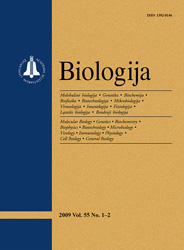Biologija / Biology
 ISSN 1392-0146 ISSN 2029-0578 (online) |
2006 m. Nr. 3 Hyperthermia modulates the effect of Ca2+ overload
on respiration and NAD(P)H fluorescence in rat
heart mitochondria
We have compared the effect of moderate heating (42 and 45 °C) on the respiration and NAD(P)H fluorescence in isolated rat heart mitochondria incubated at two different Ca2+ concentrations (1 and 10 μM). The main effect of temperature elevation above the physiological level is an increased permeability of the inner mitochondrial membrane. This effect is pronounced at 42 °C and is followed by the secondary consequences – partial uncoupling, deenergizing, decrease in NAD(P)H and in the efficiency of oxidative phosphorylation. Although less effectively, mitochondria are capable to perform energy transformation at 42 °C. This ability is almost completely lost when the temperature is raised from 42 to 45 °C. At this temperature, mitochondria are Almos completely uncoupled, they do not maintain the membrane potential and NAD(P)H/NAD(P)+ equilibrium, hardly phosphorylate, and their respiratory chain is inhibited (the latter effect is more pronounced for glutamate + malate, but also evident for pyruvate + malate oxidation). Moderate heating significantly and progressively reduced the impairment of mitochondrial function by Ca2+ overload. In comparison to the high energy state at 37 °C, Ca2+ effect on respiration is much smaller in partially deenergized mitochondria at 42 °C and minimized at 45 °C when oxidative phosphorylation is almost completely uncoupled. Temperature effects are smoothened in Ca2+ overload (10 μM Ca2+) inhibited mitochondria in comparison to mitochondria respiring at the optimal 1 μM Ca2+ concentration.
Keywords: hyperthermia, Ca2+ overload, heart mitochondria, NAD(P)H fluorescence |
Issues:
2011 - Vol.57 No. 1, No. 2, No. 3 2010 - Vol.56 No. 1-4 2009 - Vol.55 No. 1-2, No. 3-4 2008 - Vol.54 No. 1, No. 2, No. 3, No. 4 2007 - Vol.53 No. 1, No. 2, No. 3, No. 4 2006 No. 1, No. 2, No. 3, No. 4 2005 No. 1, No. 2, No. 3, No. 4 2004 No. 1, No. 2, No. 3, No. 4 2003 No. 1, No. 2, No. 3, No. 4 2002 No. 1, No. 2, No. 3, No. 4 2001 No. 1, No. 2, No. 3, No. 4 |